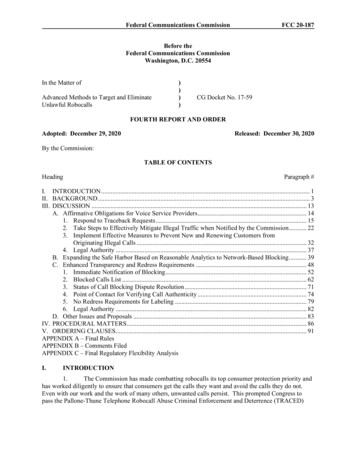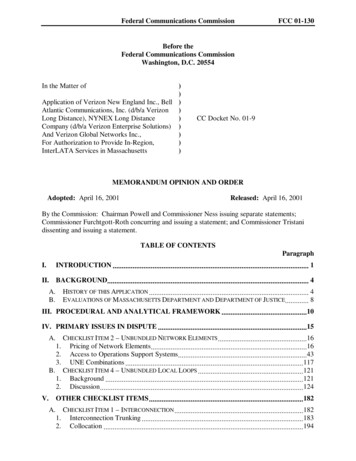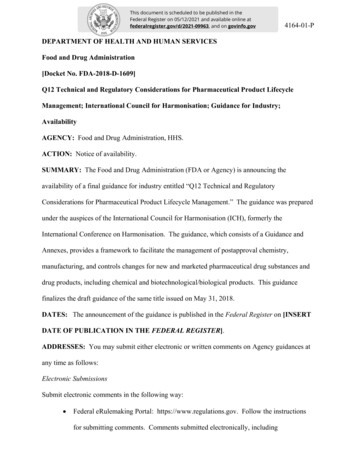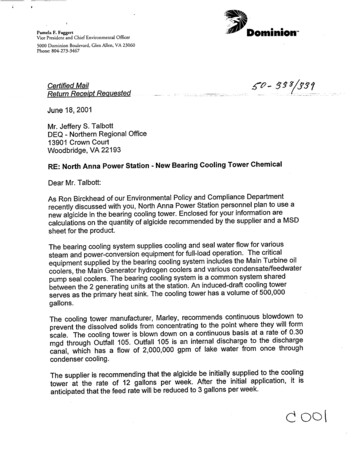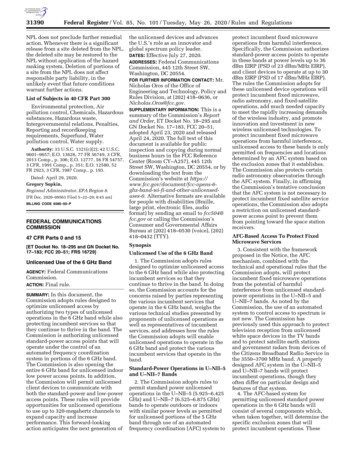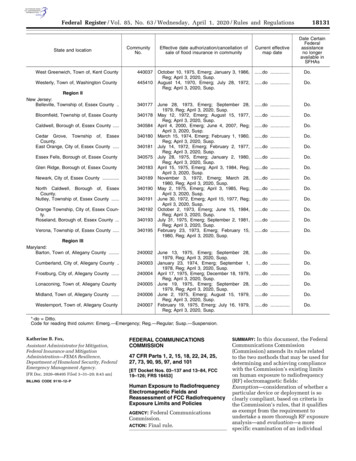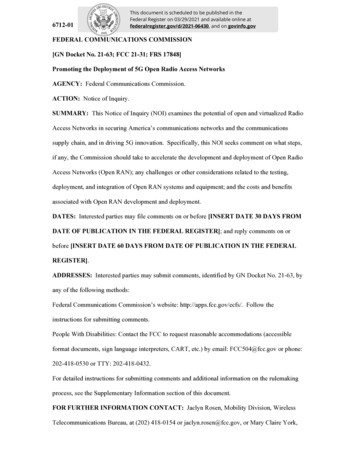
Transcription
6712-01This document is scheduled to be published in theFederal Register on 03/29/2021 and available online atfederalregister.gov/d/2021-06430, and on govinfo.govFEDERAL COMMUNICATIONS COMMISSION[GN Docket No. 21-63; FCC 21-31; FRS 17848]Promoting the Deployment of 5G Open Radio Access NetworksAGENCY: Federal Communications Commission.ACTION: Notice of Inquiry.SUMMARY: This Notice of Inquiry (NOI) examines the potential of open and virtualized RadioAccess Networks in securing America’s communications networks and the communicationssupply chain, and in driving 5G innovation. Specifically, this NOI seeks comment on what steps,if any, the Commission should take to accelerate the development and deployment of Open RadioAccess Networks (Open RAN); any challenges or other considerations related to the testing,deployment, and integration of Open RAN systems and equipment; and the costs and benefitsassociated with Open RAN development and deployment.DATES: Interested parties may file comments on or before [INSERT DATE 30 DAYS FROMDATE OF PUBLICATION IN THE FEDERAL REGISTER]; and reply comments on orbefore [INSERT DATE 60 DAYS FROM DATE OF PUBLICATION IN THE FEDERALREGISTER].ADDRESSES: Interested parties may submit comments, identified by GN Docket No. 21-63, byany of the following methods:Federal Communications Commission’s website: http://apps.fcc.gov/ecfs/. Follow theinstructions for submitting comments.People With Disabilities: Contact the FCC to request reasonable accommodations (accessibleformat documents, sign language interpreters, CART, etc.) by email: FCC504@fcc.gov or phone:202-418-0530 or TTY: 202-418-0432.For detailed instructions for submitting comments and additional information on the rulemakingprocess, see the Supplementary Information section of this document.FOR FURTHER INFORMATION CONTACT: Jaclyn Rosen, Mobility Division, WirelessTelecommunications Bureau, at (202) 418-0154 or jaclyn.rosen@fcc.gov, or Mary Claire York,
Mobility Division, Wireless Telecommunications Bureau, at (202) 418-2205 ormaryclaire.york@fcc.gov.SUPPLEMENTARY INFORMATION:Comment Filing ProceduresPursuant to sections 1.415 and 1.419 of the Commission's rules, 47 CFR 1.415, 1.419, interestedparties may file comments and reply comments on or before the dates indicated on the first pageof this document. Comments may be filed using the Commission's Electronic Comment FilingSystem (ECFS). See Electronic Filing of Documents in Rulemaking Proceedings, 63 FR24121 (1998).Electronic Filers: Comments may be filed electronically using the internet by accessing theECFS: http://apps.fcc.gov/ecfs/.Paper Filers: Parties who choose to file by paper must file an original and one copy of eachfiling. Paper filings can be sent by commercial overnight courier, or by first-class or overnightU.S. Postal Service mail.Effective March 19, 2020, and until further notice, the Commission no longer accepts any hand ormessenger delivered filings. This is a temporary measure taken to help protect the health andsafety of individuals, and to mitigate the transmission of COVID-19.1Commercial overnight mail (other than U.S. Postal Service Express Mail and Priority Mail) mustbe sent to 9050 Junction Drive, Annapolis Junction, MD 20701.U.S. Postal Service first-class, Express, and Priority mail must be addressed to 45 L Street NE,Washington, D.C. 20554.Ex Parte RulesThis proceeding shall be treated as a “permit-but-disclose” proceeding in accordance with theCommission’s ex parte rules.2 Persons making ex parte presentations must file a copy of anySee FCC Announces Closure of FCC Headquarters Open Window and Change in Hand-Delivery Policy,Public Notice, 35 FCC Rcd 2788 (2020), rs-openwindow-and-changes-hand-delivery-policy.147 CFR § 1.1200(a). Although the Rules do not generally require ex parte presentations to be treated as“permit but disclose” in Notice of Inquiry proceedings, see 47 CFR § 1.1204(b)(1), we exercise ourdiscretion in this instance, and find that the public interest is served by making ex parte presentationsavailable to the public, in order to encourage a robust record. See id. § 1.1200(a).2
written presentation or a memorandum summarizing any oral presentation within two businessdays after the presentation (unless a different deadline applicable to the Sunshine period applies).Persons making oral ex parte presentations are reminded that memoranda summarizing thepresentation must (1) list all persons attending or otherwise participating in the meeting at whichthe ex parte presentation was made, and (2) summarize all data presented and arguments madeduring the presentation. If the presentation consisted in whole or in part of the presentation ofdata or arguments already reflected in the presenter’s written comments, memoranda, or otherfilings in the proceeding, the presenter may provide citations to such data or arguments in his orher prior comments, memoranda, or other filings (specifying the relevant page and/or paragraphnumbers where such data or arguments can be found) in lieu of summarizing them in thememorandum. Documents shown or given to Commission staff during ex parte meetings aredeemed to be written ex parte presentations and must be filed consistent with Rule 1.1206(b), 47CFR 1.1206(b). Participants in this proceeding should familiarize themselves with theCommission’s ex parte rules.SYNOPSISIn creating the Federal Communications Commission (FCC or Commission), Congress chargedthe agency with protecting the safety of life and property and promoting the national defensethrough wire and radio communication. Over the last decade, actions by Congress, the ExecutiveBranch, and the Commission have repeatedly stressed and prioritized supply chain riskmanagement and the deployment of secure and reliable networks in the United States. TheCommission has worked closely with its federal partners on this critical issue and has acteddecisively to secure our communications networks and the communications supply chain.Congress has also established that it is “the policy of the United States to encourage the provisionof new technologies and services to the public.”Open and virtualized radio access networks have the potential to address national security andother concerns that the Commission and other federal stakeholders have raised in recent yearsabout network integrity and supply chain reliability. New startups are entering the originalequipment manufacturer marketplace, and many of these companies are located in trusted-partner
countries that do not pose national security risks. Network function virtualization and tools likeartificial intelligence and machine learning (AI/ML) have the potential to allow for smarter, moreefficient network security monitoring. Below, we summarize recent federal actions taken to helpsecure the communications supply chain and communications networks, either before theemergence of Open RAN or in parallel with these efforts.A. State of Development and Deployment of Open RAN SolutionsCurrent Standards and Specifications. We seek comment on the current state of standards andspecifications development for 5G and Open RAN. During the last few years, there has been aconcerted effort among some organizations to advance the Open RAN model. For example, in2016 and 2018, respectively, several companies launched the Telecom Infra Project (TIP) andglobal carriers established the O-RAN Alliance to develop and promote Open RAN referencearchitectures and protocols that foster vendor interoperability. In May 2020, several major globalcompanies formed the Open RAN Policy Coalition to promote government policies that advancethe adoption of open and interoperable RAN technologies. In August 2020, the Open NetworkingFoundation (ONF), an operator-led consortium advancing innovation in network infrastructureand carrier business models, announced several new initiatives in the Open RAN domain. Weseek comment on the state of Open RAN standards development generally and, specifically, onthe challenges inherent in developing Open RAN standards and specifications. To what extentare these standard-setting efforts being driven by established large manufacturers, and to whatextent are these efforts enabling participation by smaller equipment vendors, smaller mobilenetwork operators, and newer entrants to the marketplace? Are specifications such as eCPRI, theCommon Public Radio Interface, a sufficient alternative to Open RAN? Are there any knowninteroperable multivendor implementations of eCPRI? Are there substantive differences betweenthe eCPRI and Open RAN approaches for disaggregating the network? What steps, if any, shouldbe taken by the Commission to help resolve standard-setting challenges, bolster these efforts, andaccelerate the timeline for Open RAN standards and specifications development?Open RAN Ecosystem. We seek comment on the current state of the Open RAN ecosystem. Forexample, which companies are offering baseband hardware, network virtualization, packet core
functionality, or other network components? How large are each of these companies, in sales orrevenues, in each of these applications? How scalable is manufacturing of each of thesecomponents to allow for ramp up in production? And how many companies are competing tosupply each of the components and applications? What role (if any) will systems integrators playin advancing the deployment of Open RAN systems and what systems integrators are operating inthe marketplace today? Will carriers execute their own integration, as Rakuten has done, or buyhosted solutions from other providers? Commenters should identify any gaps or potentialbottlenecks in the Open RAN ecosystem. What factors incentivize or disincentivize vendors fromdeveloping Open RAN solutions? What are the financial capabilities and funding sources ofcurrent or potential vendors to develop such solutions? To what extent does the development ofOpen RAN solutions by one firm depend on the development of Open RAN by other firms?We seek comment on the current and future opportunities that Open RAN generates for the U.S.wireless infrastructure industry. While U.S. companies do not currently offer an integrated endto-end network at scale, several U.S. companies supply critical components of wireless networks,including semiconductors, end user devices, and core network elements. Does this suggest thatU.S. companies are well positioned to compete in a modular market? More specifically, we seekcomment and data on whether and, if so, how many U.S. companies or vendors can manufactureand/or supply Open RAN sub-components, including radios, at the scale necessary to competeboth domestically and internationally with traditional network equipment vendors. How manyU.S. companies have the knowledge and resources to begin manufacturing Open RANcomponents and applications in the near future? What are the projected market shares of the U.S.companies at the aggregate level in the U.S. wireless network equipment market if Open RANwere widely adopted? Are there any components or applications for which there currently are noU.S. suppliers?Domestic Deployments. We seek comment on the current state of Open RAN deployments in theU.S. To what extent are these solutions commercially available today? While DISH has notannounced a launch date, it is currently building the first nationwide cloud-native, Open RANbased 5G broadband network. Inland Cellular, a rural mobile wireless service provider that
serves more than 35,000 subscribers in Idaho and Washington, is reportedly deploying an OpenRAN system that will cut per site cost by approximately 40 percent. Verizon Wireless hasreportedly deployed vRAN equipment as part of its 5G network. What other U.S. companies areplanning or otherwise participating in Open RAN deployments? How close is the U.S. to beingready for large-scale deployments? Has Open RAN delivered an integrated and trulyinteroperable end-to-end process in the United States yet? Commenters should discuss previousand current efforts to deploy Open RAN in the U.S., as well as any expected plans to deploy inthe future, including information on the costs of any deployments considered. We seek commenton which mobile network operators or original equipment manufacturers are likely and not likelyto adopt Open RAN. What factors are preventing, impeding, or discouraging Open RANdeployments? What steps should be taken by the Commission, other federal partners, industry,academia, or others to resolve these issues, address these concerns, and accelerate the timeline forOpen RAN deployment?International Deployments. Similarly to the United States, several countries have stressed theimportance of securing their communications networks and communications supply chains. TheUnited Kingdom has established a 5G Supply Chain Diversification Strategy to ensure thetelecom supply chain remains resilient to future trends and threats, and French suppliers are beingprioritized to help the French government reduce its dependence on Huawei. Several countriesbelieve that Open RAN can offer a solution to security issues affecting the communicationsnetwork supply chain. The German government, for example, is expected to spend 2 billioneuros to reduce dependency on Huawei and to prioritize Open RAN research, development, anddeployments.In response to government policies and demand for more secure solutions, operators worldwideare developing and deploying Open RAN architectures at an increasing rate. For example, inAsia, Rakuten maintains it was one of the first companies to utilize Open RAN as part of its newfully virtualized cloud network in Japan, and Bharti Airtel and Vodafone Idea have been at theforefront of Open RAN deployments in India. In Europe, four major carriers – Vodafone GroupPlc, Telefonica S.A., Deutsche Telekom AG, and Orange S.A. – signed a Memorandum of
Understanding signaling their commitment to deploy Open RAN solutions across Europe. InAfrica, Vodafone has conducted early field trials, and, in July 2020, Orange announced a multicountry program to extend their current coverage with Open RAN solutions, including to theCentral African Republic. In Latin America, the TIP, Instituto Nacional de Telecomunicacoes(Inatel), and Telecom Italia Mobile (TIM) Brasil launched the Open Field program in Brazil todevelop and test Open RAN solutions in the field.As countries and operators worldwide are beginning to coalesce around the Open RAN model,we seek comment on what lessons can be learned from successful deployments, previous faileddeployments, and development efforts being undertaken in other countries. What has beenlearned about deploying Open RAN systems using existing generations of networks and in lowincome and rural environments? What challenges have these operators faced in developing anddeploying Open RAN systems? Is there anything about the U.S. wireless network industry,spectrum policies (e.g., availability of greenfield spectrum), or geographical or other factors thatpresent unique challenges to Open RAN deployment? What steps can the Commission take toencourage timely and secure domestic deployments? What implications do international effortslike the European Memorandum of Understanding have for U.S. leadership in this area?B. Potential Public Interest Benefits in Promoting Development and Deployment of OpenRANIncreased Competition and Network Vendor Diversity. We seek comment generally on the effectof Open RAN on market entry, vendor diversity, and competition in the wireless networkequipment industry. We seek comment on the current state of competition in the wirelessnetwork equipment industry generally and in the markets for various components andapplications. In particular, we seek comment on whether and how the current market structure inthe traditional RAN sector may impact or affect the deployment and adoption of Open RANsolutions. How many options are available to carriers in selecting equipment manufacturers?How interoperable is this RAN equipment, if at all, with other hardware and software? Is thisequipment or software proprietary? What restrictions, if any, do equipment manufacturers placeon wireless carriers’ equipment choices or options? Similarly, do equipment manufacturers place
any restrictions on their upstream suppliers in terms of dealing with Open RAN providers? Whataffect do such restrictions have on competition and Open RAN deployment and adoption?What are the effects of competition in the industry, and would transitioning to Open RANresolve, ameliorate, or worsen these issues? Specifically, would increased competition in thewireless network equipment marketplace result in lower costs for operators? Commentersadvocating this position should explain why and should estimate the likely cost reductions. Forinstance, does Open RAN eliminate or minimize the costs associated with developing aproprietary end-to-end network or deploying and maintaining single-vendor hardware? Whatbenefits can be gained by access to interoperable networks? On the other hand, would there beany additional costs to operators from having to use Open RAN versus alternative technologies?For example, are there any additional costs required for integrating the Open RAN system?We also seek this information on the firms that supply various network components andapplications of 5G RAN networks and their market shares in each of the segments. We seekcomment on the relationships between and among firms in this industry, including but not limitedto supplier relationships, equity investments, and joint ventures or partnerships. Commentersshould also describe the extent to which the cost, quality, and/or capabilities of competingcomponents and applications differ. We seek comment on vertical supply chain relationships inthe telecommunications networking equipment market, and on the potential effects of currentmarket conditions on the demand for and deployment of Open RAN solutions. Commentersshould identify barriers to entry or market conditions that may affect or impede the deploymentand adoption of Open RAN solutions now or in the future. Do current market conditions orbarriers to entry warrant specific regulatory intervention? If so, commenters should describewhat measures the Commission should take, as well as the legal basis for Commission action.We seek comment on the current and projected demand for Open RAN and its expected marketshare, as a proxy for predicting the level of competition in the Open RAN supply chain. By someestimates, Open RAN currently captures 9.4% of the total 4G and 5G market. Is the currentmarket share a reflection of actual demand, or is it the result of regulatory or other barriers thatmay be impeding or delaying widespread adoption and deployment? Is market share likely to
change in the future? Is there a threshold for market share at which the effectiveness of diffusionof Open RAN would rapidly increase? What are the anticipated diffusion rates over the next 5years under current market conditions? We seek comment on whether the pace of Open RANadoption should influence policies the Commission adopts, or whether the Commission shouldadopt policies to accelerate the pace of adoption. We also seek comment on any adverse effectsand costs of policies advocated by commenters, such as the extra burden on network operationsthat the policies may cause.What factors may incentivize or disincentivize operators from adopting Open RAN technologies?How would adoption by one firm impact adoption by other firms? To what extent does OpenRAN technology exhibit economies of scale, network effects, or learning curves? If the benefitsof Open RAN can only be realized by economies of scale, should the Commission providefunding or incentives to operators that choose to implement such systems in their wirelessnetworks? To what extent might government-funded incentives or other regulatory interventionease any of the costs or barriers to adopting Open RAN? For example, the Indian government iscurrently drafting procurement regulations for its next generation networks and is expected tooffer preference to domestic suppliers. In Japan, the government is providing tax incentives toproducts with open and interoperable interfaces, and the UK government announced a 28 millioneuro investment in 5G products, with more than one-half utilizing Open RAN. Should we adoptsimilar regulatory measures or incentives? Are other actions necessary to level the playing fieldfor new Open RAN suppliers that are competing against entrenched traditional vendors withdecades of experience? For instance, should we amend, forbear from applying, or eliminate anyof our rules that inadvertently support a single-vendor approach, a specific technology (e.g.,closed radio access networks), or otherwise inhibit the development and adoption of Open RANsolutions? Are there any components or factors of an Open RAN system that are or could behindered by a single or limited vendor supply? How can we facilitate a competitive marketplacewhere essential pieces of an Open RAN architecture are not controlled by a limited number ofentities?
We seek comment on whether Open RAN is likely to create opportunities for new entrants in theoriginal equipment manufacturer markets. Specifically, we seek comment on whether and, if so,which aspects of, the Open RAN architecture promote vendor diversity and competition. OpenRAN works by disaggregating software applications from the underlying hardware infrastructureand replacing proprietary interfaces between baseband components with open, standards-basedinterfaces. Would the disaggregated nature of Open RAN lower the costs of entry by allowingvendors to develop distinct components of the network (e.g., hardware, software, silicon), ratherthan having to build the integrated end-to-end system, which can be a costly undertaking? Doesthe interoperable nature of Open RAN facilitate market entry by allowing vendors to developspecific components of the network for use by multiple operators rather than creating unique oneoff solutions for specific operators? What specific firms or what kind of firms would be likelyentrants, and how are they likely to perform as competitors against incumbents? Which segmentsare they likely to enter, and what kind of products are they likely to develop? Are there likely tobe international entrants in addition to domestic entrants? Commenters should discuss otheraspects of the Open RAN architecture that may lower the barriers to entry and otherwise facilitatemarket entry.We also seek comment on how Open RAN could encourage innovation by American companies,and how to anticipate, identify, and evaluate potential issues that might stifle innovation,manufacturing, and deployment. For example, is there a sufficient workforce in place with thetraining to safely and efficiently install Open RAN equipment? If not, how quickly could suchworkers be trained? Are there steps the Commission or other federal agencies should take toaddress an increase in the supply of trained workers needed to close such a gap? Under an opensource or open-interface model, will businesses be able to stay financially viable? How willaccess to intellectual property and patents influence the ability to innovate? Can U.S. operatorscontinue to achieve the same level of features and performance at scale with Open RAN thatcustomers currently enjoy with existing infrastructure? Will technological developments in OpenRAN benefit innovation in other technologies? We seek comment on these questions as well as
comment generally on whether the Commission or other entities could or should plan for andmitigate foreseeable roadblocks.Affordability of Services and Products for Consumers. We seek comment on the potential costsand benefits of Open RAN on consumers in the next-generation wireless network marketplace. IfOpen RAN lowers the overall hardware and deployment costs for operators, are those costsavings likely to pass through to consumers in the form of lower, more competitive prices fornext-generation wireless services? How might Open RAN affect the price of services andproducts for consumers, if at all? If the federal government provides incentives for a transition inarchitecture, how can we ensure these cost savings find their way to the consumer? Commentersshould discuss the potential effect of Open RAN on the affordability of end-user services andproducts. In particular, commenters should discuss how Open RAN might affect the affordabilityof services and products for the most vulnerable consumers, including rural and low-incomeAmericans.Network Security and Public Safety. Several countries have recognized Open RAN as a potentialsolution to the increasing security threats posed to their nation’s communications supply chains.For example, as previously discussed, the German government is expected to spend two billioneuros to reduce its dependency on Huawei by prioritizing Open RAN research, development, anddeployments. France has adopted a similar policy. Through open disaggregation of the RAN,Open RAN is intended to enable the use of interchangeable modular technologies, as well asAI/ML, to promote, among other things, network security and public safety. O-RAN Allianceargues that the design of Open RAN, along with the potential for leveraging open-sourcesoftware, should improve supply chain security.To what extent does Open RAN address supply chain risk management issues and enable thedeployment of secure and reliable networks in the United States? Does the disaggregated natureof Open RAN facilitate market entry by additional vendors and therefore offer viable alternativesto the use of equipment from untrusted vendors in the telecommunications supply chain (e.g.,Huawei and ZTE)? Would Open RAN mitigate operators’ reliance on specific vendors, allowingthem to secure a back-up supplier or otherwise eliminate lock-in problems resulting from a
consolidated equipment marketplace? How would an increase in the number of vendorssupplying components for Open RAN affect the 5G vendor management ecosystem? Would theuse of Open RAN software facilitate the rapid removal of vendors’ equipment when they wereidentified as untrusted? Would a supply chain of Open RAN software vendors that excludesuntrusted entities obviate concerns of that software running over hardware of an untrustedvendor? Can additional criteria be defined to assist in identifying what is an untrusted vendor,beyond frameworks such as the Prague Proposals, EU Toolbox for 5G Security, or the Center forStrategic and International Studies Criteria? We seek information on the risk of securitybreaches, including the frequency of such breaches and the magnitude of potential economicdamages on closed RAN networks, and how this security risk could be addressed by Open RAN.We seek comment on the potential impact of Open RAN on public safety communications. Whatpotential benefits would Open RAN provide for public safety communications and emergencycommunications, such as 911 or wireless emergency alerting overall? To what extent wouldOpen RAN impact the required location accuracy of 911 calls? How and to what extent wouldOpen RAN facilitate interoperability for public safety communications, especially as state andlocal 911 systems transition to IP-based networks, such as Next Generation 911 (NG 911)?Similarly, how would Open RAN enhance interoperability with respect to NG 911, the FirstResponder Network (FirstNet), or priority services, such as wireless priority services? Howcould Open RAN reduce the overall frequency and duration of communications outages onnetworks that carry 911 and other emergency communications? What impact, if any, will thedeployment of Open RAN systems have on existing signal boosters used to ensure adequate inbuilding coverage?Open-Source Software. Open-source software “includes operating systems, applications, andprograms in which the source code is published and made available to the public, enablinganyone to copy, modify and redistribute that code.” Open RAN can leverage open-sourcesoftware for network functions and network management. Open-source software draws from alarger and more diverse set of reviewers compared to that of a closed RAN architecture. Whatare the potential benefits or advantages associated with the use of open-source software in Open
RAN environments? For instance, does open-source software result in a well-vetted, more securefinished product? How can these benefits be most effectively realized, and what role can theCommission play in maximizing these benefits? What are the disadvantages to using opensource software in Open RAN environments and how can they be mitigated?Potential Technological Benefits of Open RAN Deployment. Proponents of Open RAN argue thatfeatures such as end-to-end network slicing, edge computing, and machine learning-basednetwork optimization methods may be better enabled by standards-based architectures. Further,they contend that an open architecture could improve the controllability and overall performanceof cellular networks that are increasingly heterogenous and distributed, aggregate spectrum indifferent frequency bands, and use small-cell architectures. We seek comment on these views,and specifically on quantifying the improvement in spectral efficiency and performance under theOpen RAN architecture as compared with a closed system.One of the promised benefits of an Open RAN architecture is the ability to apply AI/MLtechniques to optimizing radio resource management, since the interfaces between differentelements of the network will be available for real-time control. Proponents argue this would beespecially beneficial in network slicing to guarantee end-to-end Quality-of-Service to disparateapplications that are allocated resources over the network. The complexity of wireless
6712-01 FEDERAL COMMUNICATIONS COMMISSION [GN Docket No. 21-63; FCC 21-31; FRS 17848] Promoting the Deployment of 5G Open Radio Access Networks AGENCY: Federal Communications Commission. ACTION: Notice of Inquiry. SUMMARY: This Notice of Inquiry (NOI) examines the potential of open and virtualized Radio Access Networks in securing America's communications networks and the communications


